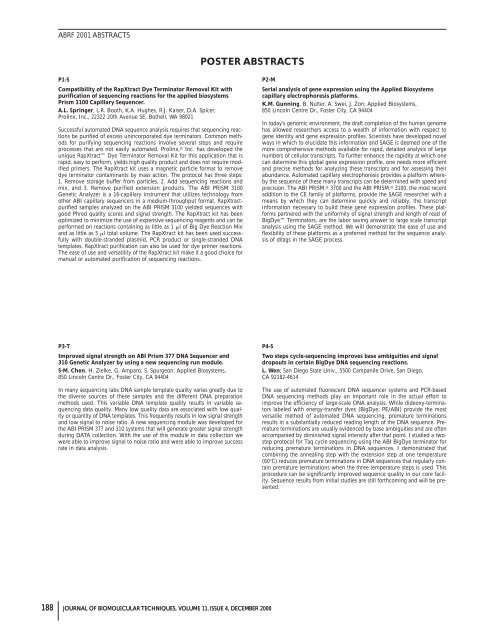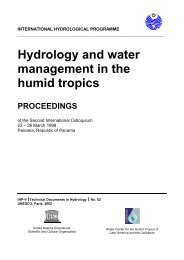FR AB - Science Reference
FR AB - Science Reference
FR AB - Science Reference
Create successful ePaper yourself
Turn your PDF publications into a flip-book with our unique Google optimized e-Paper software.
<strong>AB</strong>RF 2001 <strong>AB</strong>STRACTS<br />
P1-S<br />
Compatibility of the RapXtract Dye Terminator Removal Kit with<br />
purification of sequencing reactions for the applied biosystems<br />
Prism 3100 Capillary Sequencer.<br />
A.L. Springer, L.R. Booth, K.A. Hughes, R.J. Kaiser, D.A. Spicer;<br />
Prolinx, Inc., 22322 20th Avenue SE, Bothell, WA 98021<br />
Successful automated DNA sequence analysis requires that sequencing reactions<br />
be purified of excess unincorporated dye terminators. Common methods<br />
for purifying sequencing reactions involve several steps and require<br />
processes that are not easily automated. Prolinx, ® Inc. has developed the<br />
unique RapXtract Dye Terminator Removal Kit for this application that is<br />
rapid, easy to perform, yields high quality product and does not require modified<br />
primers. The RapXtract kit uses a magnetic particle format to remove<br />
dye terminator contaminants by mass action. The protocol has three steps:<br />
1. Remove storage buffer from particles, 2. Add sequencing reactions and<br />
mix, and 3. Remove purified extension products. The <strong>AB</strong>I PRISM 3100<br />
Genetic Analyzer is a 16-capillary instrument that utilizes technology from<br />
other <strong>AB</strong>I capillary sequencers in a medium-throughput format. RapXtractpurified<br />
samples analyzed on the <strong>AB</strong>I PRISM 3100 yielded sequences with<br />
good Phred quality scores and signal strength. The RapXtract kit has been<br />
optimized to minimize the use of expensive sequencing reagents and can be<br />
performed on reactions containing as little as 1 �l of Big Dye Reaction Mix<br />
and as little as 5 �l total volume. The RapXtract kit has been used successfully<br />
with double-stranded plasmid, PCR product or single-stranded DNA<br />
templates. RapXtract purification can also be used for dye primer reactions.<br />
The ease of use and versatility of the RapXtract kit make it a good choice for<br />
manual or automated purification of sequencing reactions.<br />
P3-T<br />
Improved signal strength on <strong>AB</strong>I Prism 377 DNA Sequencer and<br />
310 Genetic Analyzer by using a new sequencing run module.<br />
S-M. Chen, H. Zielke, G. Amparo, S. Spurgeon; Applied Biosystems,<br />
850 Lincoln Centre Dr., Foster City, CA 94404<br />
In many sequencing labs DNA sample template quality varies greatly due to<br />
the diverse sources of these samples and the different DNA preparation<br />
methods used. This variable DNA template quality results in variable sequencing<br />
data quality. Many low quality data are associated with low quality<br />
or quantity of DNA templates. This frequently results in low signal strength<br />
and low signal to noise ratio. A new sequencing module was developed for<br />
the <strong>AB</strong>I PRISM 377 and 310 systems that will generate greater signal strength<br />
during DATA collection. With the use of this module in data collection we<br />
were able to improve signal to noise ratio and were able to improve success<br />
rate in data analysis.<br />
POSTER <strong>AB</strong>STRACTS<br />
188 JOURNAL OF BIOMOLECULAR TECHNIQUES, VOLUME 11, ISSUE 4, DECEMBER 2000<br />
P2-M<br />
Serial analysis of gene expression using the Applied Biosystems<br />
capillary electrophoresis platforms.<br />
K.M. Gunning, B. Nutter, A. Swei, J. Zon; Applied Biosystems,<br />
850 Lincoln Centre Dr., Foster City, CA 94404<br />
In today’s genomic environment, the draft completion of the human genome<br />
has allowed researchers access to a wealth of information with respect to<br />
gene identity and gene expression profiles. Scientists have developed novel<br />
ways in which to elucidate this information and SAGE is deemed one of the<br />
more comprehensive methods available for rapid, detailed analysis of large<br />
numbers of cellular transcripts. To further enhance the rapidity at which one<br />
can determine this global gene expression profile, one needs more efficient<br />
and precise methods for analyzing these transcripts and for assessing their<br />
abundance. Automated capillary electrophoresis provides a platform whereby<br />
the sequence of these many transcripts can be determined with speed and<br />
precision. The <strong>AB</strong>I PRISM. ® 3700 and the <strong>AB</strong>I PRISM. ® 3100, the most recent<br />
addition to the CE family of platforms, provide the SAGE researcher with a<br />
means by which they can determine quickly and reliably, the transcript<br />
information necessary to build these gene expression profiles. These platforms<br />
partnered with the uniformity of signal strength and length of read of<br />
BigDye Terminators, are the labor saving answer to large scale transcript<br />
analysis using the SAGE method. We will demonstrate the ease of use and<br />
flexibility of these platforms as a preferred method for the sequence analysis<br />
of ditags in the SAGE process.<br />
P4-S<br />
Two steps cycle-sequencing improves base ambiguities and signal<br />
dropouts in certain BigDye DNA sequencing reactions.<br />
L. Wen; San Diego State Univ., 5500 Campanile Drive, San Diego,<br />
CA 92182-4614<br />
The use of automated fluorescent DNA sequencer systems and PCR-based<br />
DNA sequencing methods play an important role in the actual effort to<br />
improve the efficiency of large-scale DNA analysis. While dideoxy-terminators<br />
labeled with energy-transfer dyes (BigDye; PE/<strong>AB</strong>I) provide the most<br />
versatile method of automated DNA sequencing, premature terminations<br />
results in a substantially reduced reading length of the DNA sequence. Premature<br />
terminations are usually evidenced by base ambiguities and are often<br />
accompanied by diminished signal intensity after that point. I studied a twostep<br />
protocol for Taq cycle sequencing using the <strong>AB</strong>I BigDye terminator for<br />
reducing premature terminations in DNA sequences. I demonstrated that<br />
combining the annealing step with the extension step at one temperature<br />
(60�C) reduces premature terminations in DNA sequences that regularly contain<br />
premature terminations when the three temperature steps is used. This<br />
procedure can be significantly improved sequence quality in our core facility.<br />
Sequence results from initial studies are still forthcoming and will be presented.















